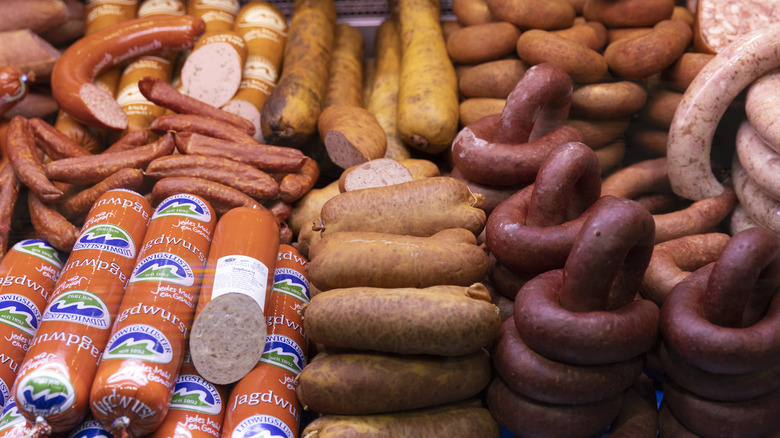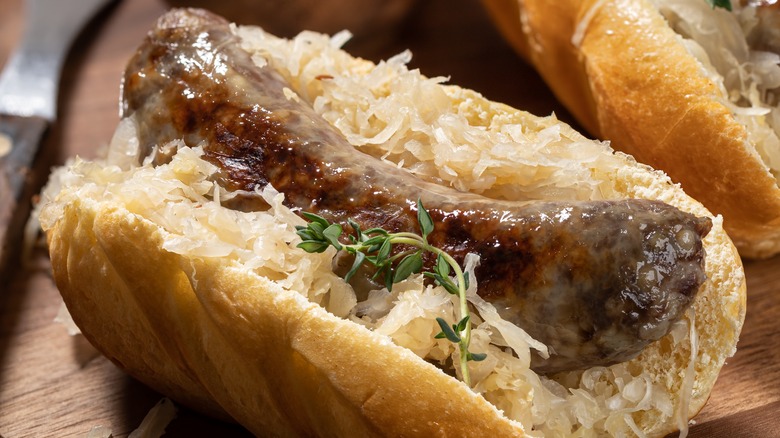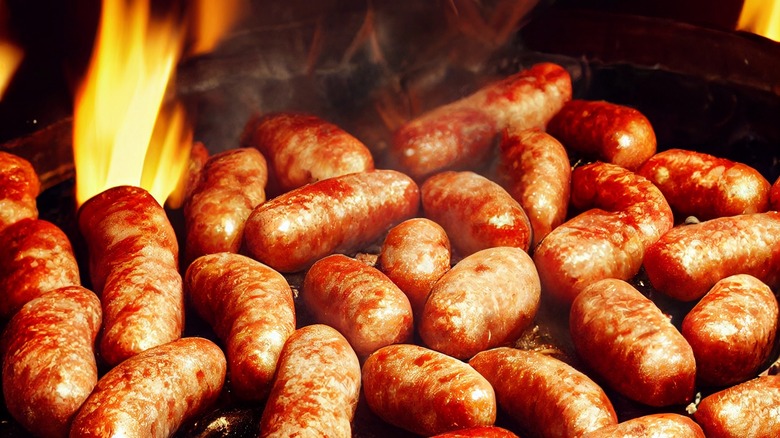17 Of The Most Popular Types Of Sausage From Around The World
Whether you grill it up and eat it on a bun, fry it to add to some of your favorite recipes, or eat it for breakfast — sausage is probably a staple in your diet.
Just browsing through the shelves at the grocery store, you can find several different types of sausage. Some may be made with pork, while others may feature turkey, beef, or another protein as their base. Some types of sausage are even vegan. Beyond the different types of protein used for sausage, the other ingredients and spices can vary widely between different varieties.
You likely already know that there are different types of sausage out there, and you may even realize that many of them originate from other countries. But did you realize that there are actually hundreds of varieties of sausage found around the world? Let's take a look at some of the most popular varieties.
1. Bratwurst: Germany
Bratwurst is arguably one of the most popular types of sausage. It is a German sausage that was created to reduce waste after slaughtering a pig. While pork is the traditional type of meat used for this sausage, other varieties may feature veal or beef. In addition to the protein, one of the other key features of bratwurst is its seasonings. These may include pepper, sage, clove, ginger, and nutmeg. Brats typically have a stronger seasoning profile than some other milder sausages.
This food is made using raw meat, so it must be cooked before consumption. You can cook it however you would like, but two of the most popular methods are grilling and frying. There are many ways to enjoy bratwurst, but the most traditional option would be to eat it on a hard roll. Top the bratwurst with some sauerkraut and spicy mustard. Serve it with a side of potato salad for an authentic German lunch.
2. Chorizo: Spain
Chorizo is another type of sausage that you've probably heard of. There are actually two different Chorizo variations: one from Spain and one from Mexico. They each have their own key characteristics and are used in different ways, so they are typically referred to as two different types of sausage. Let's start by taking a look at the Spanish variation.
Spanish chorizo is made by combining finely ground meat — traditionally pork — with paprika and other seasonings. The sausage is smoky. It could be mild or spicy depending on the specific seasonings used when making it. The preparation process involves curing and smoking the sausages, meaning that they are fully cooked when sold.
When deciding how to enjoy Spanish chorizo, there are a few different options you could consider. The first would be to slice it and add it to soup or stews. You could also add it to other recipes, like paella. Another way the sausage is served in Spain is by pairing it with cheese to enjoy as a snack.
3. Andouille: France
Andouille is a type of French sausage. If you enjoy Cajun dishes like gumbo and jambalaya, you will probably like Andouille sausage. One of the defining characteristics of Andouille is that it is made from a pig's digestive tract. The animal's small intestines and stomach are finely chopped and combined with onions and various seasonings. Once mixed, all of the ingredients are added to the casing (which is made from the large intestine of a pig) before poaching.
Cajun-style Andouille, most commonly found in the United States, is made in a slightly different manner. It combines meat from a pig's upper shoulder with strong seasoning. Once put in the casing, the finished sausage is smoked. In addition to adding Andouille to all of your favorite Cajun recipes, there are several other ways you can enjoy it. Because it is fully cooked, consider adding it to a meat and cheese board for an appetizer. Alternatively, boil or bake Andouille and add it to your favorite rice and pasta recipes.
4. Laulau: Hawaii
Laulau may not match your vision of a traditional sausage. Rather than being placed inside a casing, this popular Hawaiian food is wrapped in taro plant leaves, called lūʻau leaves.
It is most commonly made using pork. But other proteins, such as fish, chicken, or beef, can also be used. The other key component of laulau is salted butterfish. The salted butterfish (also known as black cod) is added as a second layer in the wrap around the protein.
Years ago, laulau was cooked in an imu. This underground oven used hot rocks to cook foods. Today, it is most often steamed on the stovetop. Laulau is considered a Hawaiian comfort food by many. If you ever go to Hawaii and order a plate lunch, you'll notice that many feature laulau. With these plate lunches, you're likely to see the laulau served alongside rice and macaroni salad.
5. Sai Ua: Thailand
While sai ua originated in the northern regions of Thailand, the sausage has gained a lot of popularity, and can now be found across the country. Sai ua translates to stuffed intestine, the basic definition of what this sausage is.
Sai ua has a very aromatic flavor, which is imparted by the regional ingredients used to make it. In addition to the pork protein, sai ua recipes often call for red curry paste, lemongrass, turmeric, galangal, and makrut lime leaves. While these ingredients may be hard to come by — especially fresh — in many parts of the world, they are much more common in Thailand.
Sai ua is made using minced pork, giving the sausage a coarser texture than many other types. Grilling is one of the most common ways to enjoy eating it. In Thailand, it is often paired with sticky rice and eaten as an appetizer.
6. Chorizo: Mexico
While Spanish chorizo is smoked — making it fully cooked — Mexican chorizo is sold raw. It needs to be cooked before consumption. However, this isn't the only difference between the two variations.
While Spanish chorizo is traditionally made with pork, Mexican chorizo could also be made with beef. Mexican chorizo is also spicier than its Spanish counterpart. In addition to the protein used for this sausage, it is also made using red peppers and various other seasonings, such as clove and cinnamon.
There are many different ways to enjoy Mexican chorizo. Because of how it is seasoned during the preparation process, you won't need to do much to enhance its flavor. You can add Mexican chorizo to tacos, burritos, nachos, or any of your favorite Mexican recipes. You could also grill it up to add to omelets, put it as a topping on a hamburger, or use it any other way you'd like.
7. Boerewors: South Africa
South African boerewors sausage must be made using beef. However, other types of protein, including lamb or pork may be added to the recipe. The coil-shaped sausage is also required to have a meat content of at least 90%. Moreover, the meat used to make it may not have a total fat content greater than 30%. Vinegar and various other ingredients and spices — like black pepper, coriander, allspice, and nutmeg — make up the last 10% of the recipe.
Beyond its distinct flavor, boerewors also has a more unique texture, compared to many other popular sausage types. The meat used to make it is not as finely ground, meaning its texture is not as smooth as you may be used to.
Boerewors is a popular dish served at South African barbecues, called braais. The large coil is grilled up and guests are served slices to pair with the other sides and entrée options. Some of the foods commonly served alongside boerewors include meat kebabs called sosatsies. Grilled cheese, onion, and tomato sandwiches called braaibroodjies are another option. You may also see people enjoying their boerewors on a bun.
8. Salsiccia: Italy
Salsiccia is a term that refers to fresh Italian sausages. Most are made using ground or finely minced pork. The ground pork meat is often combined with pancetta scraps or pieces of pork neck.
The seasonings and other ingredients added to salsiccia vary in different regions of Italy. In the southern regions of the country, garlic, fennel, sun-dried tomatoes, and chili peppers are commonly added. Bits of cheese — specifically caciocavallo cheese — are also added to the recipe. The flavor of the salsiccia sausage will be different in northern regions of the country. There, it is traditionally prepared with white wine, garlic, cinnamon, and pepper.
Grilling the sausage is one of the top ways to eat it. When grilling — or cooking using another method — chefs poke small holes about an inch apart into the sausage using a needle or toothpick. These tiny holes ensure that some of the fat will drain as the sausage cooks. You can add salsiccia sausage to stews, pasta dishes, sandwiches, pizzas, and more.
9. Longganisa: Philippines
Longganisa is a type of Filipino sausage. The name longganisa sounds similar to longaniza, an Argentinian sausage. The reason both of these countries have sausage with similar names can be attributed to Spain colonizing both areas.
In the Philippines, the term longganisa is used when talking about any type of sausage that is made using spices found in the country. While there are several different types of longganisa in the Philippines, most feature either pork, chicken, or beef as the protein. Similarly, Prague powder is a common ingredient across many of the different varieties. Longganisa is most commonly sold fresh, meaning it must be cooked before consumption.
This type of sausage is a popular addition to many breakfast dishes. However, it is also viewed as an excellent addition to a lunch or dinner. In many cases, you'll find longganisa served with pickled vegetables or vinegar. Because there are so many different variations of longganisa throughout the Philippines — and each has its own unique flavor — the ways it can be enjoyed can also vary widely. There are two main types of Longganisa that you may see: savory and salty longganisa (referred to as "de recado") and sweeter longganisa (referred to as "hamonado").
10. Breakfast sausage: America
While it is such a staple now, breakfast sausage hasn't always been around. However, it does have a long history in this country. About 300 years ago, in the 1800s, farmers came up with the idea of making breakfast sausage to help create a more filling meal to enjoy at the beginning of the day. The farmers didn't want to waste parts of the animals that they slaughtered, so they used them to make sausage. Not only was breakfast sausage satisfying and a good way to reduce waste, but it was also more affordable, which helped it gain popularity.
You can find breakfast sausage everywhere now, from the grocery shelves to nearly any restaurant's breakfast menu. It may be sold in link or patty form. Breakfast sausage is traditionally made with pork, though you can find several other variations today. The pork (or other protein) is ground before being mixed with some seasonings. While various seasonings are added to breakfast sausage, it has a much more mild taste than other types of sausage more commonly consumed for lunch or dinner. Browning on a skillet is the traditional way to prepare it.
11. Sucuk: Turkey
Sucuk is a type of spicy sausage from Turkey. Also spelled soudjouk or sujuk, this type of sausage is made using beef and occasionally some lamb. In addition to being popular in Turkey, there are similar variations that you may find in the Middle East, Eastern European countries, or the Balkans.
When sucuk is made, ground beef is combined with seasonings such as sumac, garlic, cayenne pepper, and cumin. After the beef and seasoning mixture is added to the casings, it is cured or dried.
Sucuk has a unique flavor. It is also a fattier sausage than several other varieties. Its higher fat content and seasoning profile allow it to enhance the taste of many different dishes. It may be added to stews, namely kuru fasulye, a tomato and navy bean stew popular in Turkey. Sucuk is also served with breakfast in egg dishes or on a platter with bread, olives, and fruit.
12. Black Pudding: United Kingdom
If you've ever eaten a traditional English or Irish breakfast, you may have already tasted black pudding. But, do you know exactly what it is that you ate?
Black pudding has a key distinction from other types of sausages: it is made using blood. The blood is mixed with oatmeal and cooked until it becomes thicker. As it cools, the mixture will congeal, giving it its classic texture.
Compared to other types of sausage, black pudding is a healthier selection. It is high in protein, while low in carbs and calories. In addition to being served alongside a traditional Irish or English breakfast (where slices of it are typically fried), black pudding can also be added to other dishes. For example, you can crumble it and add it to your gravy for added flavor, or add it to mashed potatoes for a spin on the classic recipe.
13. White Pudding: Ireland
Now that you know what black pudding is, what about white pudding? Despite their similar names, white pudding and black pudding are not the same. While black pudding is made using blood, no blood is added to white pudding. Rather, the traditional recipe — which originates from Ireland — includes pork meat or pork liver, along with oatmeal, bread, and suet (animal fat). With Irish white pudding, potato flour and spices may also be added to enhance the flavor of the sausage.
White pudding is another classic component of a traditional Irish breakfast. Some of the other parts of an Irish breakfast include eggs, bacon, baked beans, potatoes, mushrooms, and toast. When served alongside breakfast entrées, the sausage is commonly cut into slices before frying or grilling it. Despite the name, a traditional Irish breakfast may be eaten at other times of the day, such as for lunch. The flavor of white pudding is much lighter and more subtle than that of black pudding.
14. Wiejska: Poland
Wiejska kielbasa from Poland is one of the most popular sausage types in the European country. Traditionally made using both ground pork and ground veal, wiejska has a delicious flavor. In addition to the ground pork and veal, recipes call for seasonings, namely marjoram and garlic. Wiejska translates to a rural, or country area in Polish. The sausage was likely first developed away from the busier cities.
The sausage is smoked, meaning it is safe to consume without cooking. You can even thinly slice it to make a sandwich. You could even simply leave the wiejska whole and place it on a bun with some sauerkraut and mustard. The kielbasa can be cooked in many ways, allowing you to create many flavorful meals. Consider grilling, frying, or baking wiejska before adding it to your favorite stew, casserole, or pasta dish. You'll notice its amazing flavor with the first bite.
15. Käsekrainer: Austria
If you ever take a trip to Austria, you may have the opportunity to order Käsekrainer sausage. This sausage variety is plump and contains several bits of cheese throughout (Käse means cheese in German) which is why this sausage was given its name. The inclusion of cheese inside the casing does more than offer a unique and flavorful taste to the sausage — but it can actually make it almost hazardous to cut into. If you don't take extra care when cutting it, the molten cheese on a freshly cooked sausage may come spewing out when a knife punctures the casing.
Käsekrainer tastes incredible when paired with a roll, mustard, and ketchup — this is how it is most typically served at sausage stands throughout Vienna and other parts of Austria. But there are no rules saying you couldn't grill it up to include in a favorite pasta or rice dish. However you eat it, the gooey cheese is going to help it taste amazing.
16. Kupati: Georgia
Do you enjoy spicy sausage? If so, you might want to try kupati. This Georgian sausage gets its spice from the coriander, black pepper, and garlic that are added to the recipe. Some of the other key ingredients include cinnamon and onions, but you can also find variations that incorporate parsley, mushrooms, cheese, or potatoes. Traditional kupati recipes feature either pork or beef. When the sausage is prepared, the casings are shaped into horseshoes.
In the Caucasus region, where many people enjoy Kupati, you'll often find it served with sauerkraut. Pomegranate seeds and coriander may also top the sausage, serving as a garnish. While you could choose to boil or bake kupati, grilling or frying are the ways you're more likely to see it prepared. Keep in mind that kupati is a raw sausage. This means that you will need to cook it before eating it. It cannot simply be sliced and eaten as you can do with some other types of sausage.
17. Sundae Sausage: South Korea
Sundae sausage, also spelled soondae, comes from South Korea. It is a type of blood sausage made with pig's blood, glass noodles, and rice. Other ingredients — such as fish, squid, bean sprouts, soybean paste, scallion, barley, or kimchi — can also be found in some regional variations. Because of its ingredients, the texture of Sundae sausage is different from what you'd traditionally think of with sausage. While it is quite dense with all of the different ingredients stuffed together, the noodles and rice give it more of a gelatinous texture.
The original variety of the sausage is believed to have first been developed between 918 and 1392 during the Goryeo period. There are many different ways you can eat Sundae sausage. One option is to brown it, slice it, and pair it with apples or potatoes to help balance out its higher iron content. Sundae sausage is also a key ingredient in various Korean dishes such as stir-fry (sundae bokkeum) or soup (sundaeguk).

















